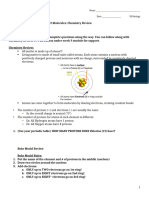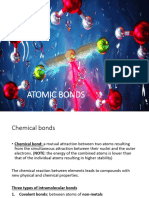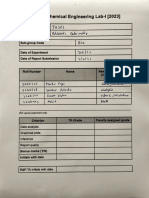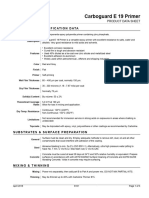Chapter 7 Review: Vocabulary Section 7.3
Uploaded by
Christopher HurtChapter 7 Review: Vocabulary Section 7.3
Uploaded by
Christopher HurtChapter 7 Review
Vocabulary 10. _____________ form bonds and _____________
do not form bonds.
Match each word to the sentence where it best
fits. Section 7.3
Section 7.1 isomer lone pair
VSEPR tetrahedral
electrostatic force polarize
region of electron trigonal pyramidal
nonpolar covalent polar covalent bond density
bond bent
ionic bond trigonal planar
1. The _____________ is what holds atoms together 11. If an atom has a/an _____________ then some
in bonds. valence electrons will not be shared in covalent
2. When the electrons are shared unevenly between bonds.
two atoms they cause the molecule to 12. You can predict the shapes of simple molecules
_____________ in that area. using _____________ theory.
3. A/An _____________ forms when electrons are 13. Each bond and each pair of electrons not shared in
shared unevenly between atoms. a bond around an atom is considered to be a/an
4. If one or more electrons are transferred between _____________.
atoms causing them to become positively and 14. If you can make more then one molecule from the
negatively charged, then a/an _____________ same set of atoms, then each molecule made from
forms. that set is called a/an _____________.
5. If two atoms have the same or very similar 15. The shape typically formed in a molecule around
electronegativities, then the bond between them an oxygen atom is _____________.
will be a/an _____________.
16. There are two shapes that involve four atoms. The
one that has all the atoms lying flat is
Section 7.2 _____________, whereas the one where they can’t
be all placed in the same flat surface is
free radical antioxidant _____________.
octet rule covalent bonds 17. If you had four things that are trying to repel as far
unpaired electrons paired electrons away from each other as possible, they will point
into the corners of a/an _____________ shape.
6. A/An _____________ is highly reactive as a result
of having one unpaired electron and can do
damage to other necessary molecules in your cells.
Conceptual Questions
7. One reason dark-colored fruits and vegetables are
considered healthy is their high content of
Section 7.1
_____________ molecules. 18. Why don’t all atoms repel each other if the outer
8. The _____________ states that elements transfer part of the atom consists of negative electrons?
or share electrons in chemical bonds to reach a 19. Describe why sharing electrons causes atoms to
stable configuration of eight electrons. bond together.
9. In _____________ electrons are shared between 20. In a ball-and-stick view of a molecule, what do the
atoms instead of transferred. sticks represent?
224 A NATURAL APPROACH TO CHEMISTRY
21. Describe the main difference between covalent 31. All of the atoms are the same in a chunk of metal,
and ionic bonds. so they all have the same ionization energy and
22. The surface view of a molecule makes it look like electronegativity; they are both low. Why don’t we
the molecule is solid. What does this surface really call the type of bonds formed between the atoms
represent? in a metal “covalent bonds”?
23. Describe what the red, white, and blue colors 32. Most molecules are made from more than two
applied to some surface views of a molecule tell atoms bonded together, so there is more than just a
you about the charge of the molecule near that part single bond in a typical molecule. If one of the
of its surface. bonds is a polar covalent bond, but the rest of the
bonds are nonpolar covalent bonds, then what can
24. If a covalent bond is formed when electrons are you conclude?
shared between two atoms, then what must be true
of the electronegativity of both atoms? a. The molecule is considered to be nonpolar.
b. The molecule is considered to be polar.
a. The electronegativities must be very different
for each atom. c. The molecule has a polar part or may be
entirely polar.
b. The electronegativities must be exactly the
same for each atom.
c. The electronegativities must be similar, but not Section 7.2
necessarily the same. 33. Why do atoms of elements in the same group on
25. Explain the reasoning behind your answer to the the periodic table tend to form the same charge if
previous question. Be sure to talk about the effect they become an ion, or form the same number of
an atom’s electronegativity has on the electrons. covalent bonds when bonded in this way to other
26. Describe the difference in how electrons are atoms?
shared in a nonpolar covalent bond versus a polar 34. Using the properties of ionization energy and
covalent bond. electronegativity, explain why atoms of elements
27. Which of the molecules below is bonded together from the left side of the periodic table tend to form
with a polar covalent bond, and how do you positive ions but atoms from elements on the right
know? side of the table form negative ions.
35. Which valence electrons are the ones involved in
ionization and covalent bonding?
a. the unpaired electrons from the Lewis dot
diagram of the neutral unbonded atom
b. the paired electrons from the Lewis dot
diagram of the neutral unbonded atom
28. Which part of molecule “B” in the previous 36. How many different isomers are shown below?
question is partially negative?
29. Why does having one atom with low ionization
energy and low electronegativity paired with an
atom that has high ionization energy and high
electronegativity result in the formation of ions
and an ionic bond?
30. Why do most atomic level images of ionic
substances show many atoms forming a crystal,
but images of molecular substances usually just
show a specific set of bonded atoms?
A NATURAL APPROACH TO CHEMISTRY 225
Chapter 7 Review
37. Are these two molecules isomers of each other or 44. What are the three different possible shapes
not? Explain. formed around an atom that is surrounded by four
regions of electron density?
Quantitative Problems
Section 7.1
45. Polar covalent bonds form when electrons are
shared unevenly. Because electrons are not fully
38. How many valence electrons surround a stable transferred, this means they form partially
atom in a Lewis dot configuration? negative and partially positive charges on the
39. Formaldehyde has the formula atoms. What color indicates a partial positive and
CH2O and has one double bond what color indicates a partial negative charge on
to allow all atoms to form stable parts of a molecule?
valence structures. Explain why
this initial attempt to come up Section 7.2
with the correct Lewis dot 46. Calculate the type of bond that will form between
structure will not work. the following pairs of atoms:
40. Describe in your own words what Valence Shell a. carbon and hydrogen
Electron Repulsion Theory is and what it is used
b. oxygen and hydrogen
for.
c. lithium and bromine
41. A region of electron density is:
d. carbon and oxygen
a. the electrons shared in a bond e. fluorine and fluorine
b. the electrons that form the inner core of the
47. Bonds formed between atoms with an
atom
electronegativity difference of less than 0.5 are
c. the valence electrons that are not shared and considered to be:
are called lone pairs
a. nonpolar covalent
d. both A and C
b. polar covalent
42. Which number of regions of electron density will
give you which molecular shapes? Match the c. ionic
correct number with the correct shape. 48. Bonds formed between atoms with an
electronegativity difference between 0.5 and 2.1
Regions of Shape are considered to be:
electron density a. nonpolar covalent
2 tetrahedral b. polar covalent
3 linear c. ionic
49. Bonds formed between atoms with an
4 trigonal planar electronegativity difference greater than 2.1 are
considered to be:
43. Describe the difference between trigonal planar a. nonpolar covalent
and trigonal pyramidal shapes. b. polar covalent
c. ionic
226 A NATURAL APPROACH TO CHEMISTRY
50. Most of the molecules in gasoline have the Section 7.3
formula C8H18. Is gasoline a polar or nonpolar
covalent molecule? 56. Write the Lewis dot structure and structural
formula for PH3.
51. Some amino acids have polar side chains and
some do not. The tyrosine side chain is shown in 57. Write the Lewis dot structure and structural
the green box in the drawing. formula for C2H6.
58. Write the Lewis dot structure and structural
formula for CBr4.
59. Write the Lewis dot structure and structural
formula for CH5N.
60. Write the Lewis dot structure and structural
formula for P2H2.
61. Write the Lewis dot structure and structural
formula for SiH3N.
a. Is the side chain for tyrosine polar or not? 62. Write the Lewis dot structure and structural
b. If it is polar, are all of the bonds polar or just formula for HCP.
some of them? 63. Write the Lewis dot structure and structural
c. If just some of them are polar which bonds are formula for N2.
polar and which ones are not?
64. Write as many isomers of the Lewis dot structure
52. Describe the relationship between the electron and structural formula for CH3ON as you can.
configuration of the noble gases and the charge
65. What is the Lewis dot structure and structural
formed by specific ions. Give at least two
formula for erythrose, shown here?
examples and use electron configurations to
support your answer.
53. Describe the relationship between the electron
configuration of the noble gases and the number of
covalent bonds formed by specific atoms. Give at
least two examples and use electron
configurations to support your answer.
54. What is the most stable number of valence
electrons to have and how do you know?
55. What ratio of ions will be formed in the following
substances, so that the positively charged ions will 66. For each of the previous problems (58, 59, 62, and
cancel out the negatively charged ions? 64) describe how many regions of electron density
exist for the carbon atoms in those molecules.
a. sodium sulfide (Na and S)
b. magnesium chloride (Mg and Cl) 67. If part of a molecule is linear, what is the angle
formed between adjacent bonds?
c. aluminum oxide (Al and O)
68. If part of a molecule is trigonal planar, what is the
angle formed between adjacent bonds?
69. If part of a molecule is tetrahedral, what is the
angle formed between adjacent bonds?
A NATURAL APPROACH TO CHEMISTRY 227
You might also like
- Group 1 Lesson Plan 3 Substances and Mixtures100% (5)Group 1 Lesson Plan 3 Substances and Mixtures6 pages
- Use The Following Information To Answer The Next QuestionNo ratings yetUse The Following Information To Answer The Next Question6 pages
- CHAPTER 1 - Covalent Bonding and Shapes of MoleculesNo ratings yetCHAPTER 1 - Covalent Bonding and Shapes of Molecules10 pages
- New CHY3201 Chapter 1 Structure and BondingNo ratings yetNew CHY3201 Chapter 1 Structure and Bonding64 pages
- Summary Questions For Chapter 1 - 4 of BIOL 1101No ratings yetSummary Questions For Chapter 1 - 4 of BIOL 110134 pages
- Prelim Org Chem Lecture Notes Chap 1 Intro To Organic ChemistryNo ratings yetPrelim Org Chem Lecture Notes Chap 1 Intro To Organic Chemistry5 pages
- Chemical Bonding: William L. Masterton Cecile N. HurleyNo ratings yetChemical Bonding: William L. Masterton Cecile N. Hurley71 pages
- CHE 108 Lewis Dot Supplemental InformationNo ratings yetCHE 108 Lewis Dot Supplemental Information6 pages
- Te-Carbon and Its Compounds Final Revisor (20223-24)No ratings yetTe-Carbon and Its Compounds Final Revisor (20223-24)107 pages
- PS Gr 11 Session 10 LN - Chemical BondingNo ratings yetPS Gr 11 Session 10 LN - Chemical Bonding7 pages
- Chem Int CC CH 09 - Covalent Bonding - Answers (09.15)No ratings yetChem Int CC CH 09 - Covalent Bonding - Answers (09.15)15 pages
- Carbon and its Compounds WS 1(Bonding in Carbon - The Covalent Bond)-5No ratings yetCarbon and its Compounds WS 1(Bonding in Carbon - The Covalent Bond)-56 pages
- Chemistry 2070 Prelim Ii Answers November 8, 2012: (P Lease Print) Last F Irst Corn Ell N EtidNo ratings yetChemistry 2070 Prelim Ii Answers November 8, 2012: (P Lease Print) Last F Irst Corn Ell N Etid13 pages
- Electron Dot Diagrams / Lewis Structures: Atom and Covalent Compound Diagramming100% (1)Electron Dot Diagrams / Lewis Structures: Atom and Covalent Compound Diagramming50 pages
- Chemical Bonding and Molecular StructureNo ratings yetChemical Bonding and Molecular Structure78 pages
- Organic Chemistry,: Structure & BondingNo ratings yetOrganic Chemistry,: Structure & Bonding74 pages
- 6 C15 Notes CH4 Chemical BondsSTEM StudentsNo ratings yet6 C15 Notes CH4 Chemical BondsSTEM Students12 pages
- Chemical Engineering Board Exam Questions (Edited)No ratings yetChemical Engineering Board Exam Questions (Edited)11 pages
- 7000 Engineering Technical Ebooks Free Download Links74% (19)7000 Engineering Technical Ebooks Free Download Links701 pages
- The Potentials of Groundnut Shell Ash As ConcreteNo ratings yetThe Potentials of Groundnut Shell Ash As Concrete9 pages
- ASSE 1050-2021: American National StandardNo ratings yetASSE 1050-2021: American National Standard24 pages
- Chapter: Light: Class: 8 Paper: PhysicsNo ratings yetChapter: Light: Class: 8 Paper: Physics16 pages
- Code of Practice for the Storage and Transport of Edible Fats and Oils in BulkNo ratings yetCode of Practice for the Storage and Transport of Edible Fats and Oils in Bulk14 pages
- MCSS550.Caustic Soda 5 - 50% (11-106ºTW) v6No ratings yetMCSS550.Caustic Soda 5 - 50% (11-106ºTW) v620 pages
- 3 Classification of Elements and Periodicity in Properties: SolutionsNo ratings yet3 Classification of Elements and Periodicity in Properties: Solutions14 pages
- Physical Chemistry 1st Semester - Experiment-3No ratings yetPhysical Chemistry 1st Semester - Experiment-34 pages
- MATIAS RODRIGUEZ TAYLOR - Biology Milestone Review Tasks 1 & 2: Biochemistry of Life - Kami Converted.pdf.KamiNo ratings yetMATIAS RODRIGUEZ TAYLOR - Biology Milestone Review Tasks 1 & 2: Biochemistry of Life - Kami Converted.pdf.Kami2 pages
- Ammonia Removal Using Activated Carbons: Effect of The Surface Chemistry in Dry and Moist ConditionsNo ratings yetAmmonia Removal Using Activated Carbons: Effect of The Surface Chemistry in Dry and Moist Conditions19 pages
- Use The Following Information To Answer The Next QuestionUse The Following Information To Answer The Next Question
- CHAPTER 1 - Covalent Bonding and Shapes of MoleculesCHAPTER 1 - Covalent Bonding and Shapes of Molecules
- Prelim Org Chem Lecture Notes Chap 1 Intro To Organic ChemistryPrelim Org Chem Lecture Notes Chap 1 Intro To Organic Chemistry
- Chemical Bonding: William L. Masterton Cecile N. HurleyChemical Bonding: William L. Masterton Cecile N. Hurley
- Te-Carbon and Its Compounds Final Revisor (20223-24)Te-Carbon and Its Compounds Final Revisor (20223-24)
- Chem Int CC CH 09 - Covalent Bonding - Answers (09.15)Chem Int CC CH 09 - Covalent Bonding - Answers (09.15)
- Carbon and its Compounds WS 1(Bonding in Carbon - The Covalent Bond)-5Carbon and its Compounds WS 1(Bonding in Carbon - The Covalent Bond)-5
- Chemistry 2070 Prelim Ii Answers November 8, 2012: (P Lease Print) Last F Irst Corn Ell N EtidChemistry 2070 Prelim Ii Answers November 8, 2012: (P Lease Print) Last F Irst Corn Ell N Etid
- Electron Dot Diagrams / Lewis Structures: Atom and Covalent Compound DiagrammingElectron Dot Diagrams / Lewis Structures: Atom and Covalent Compound Diagramming
- Chemical Engineering Board Exam Questions (Edited)Chemical Engineering Board Exam Questions (Edited)
- 7000 Engineering Technical Ebooks Free Download Links7000 Engineering Technical Ebooks Free Download Links
- Code of Practice for the Storage and Transport of Edible Fats and Oils in BulkCode of Practice for the Storage and Transport of Edible Fats and Oils in Bulk
- 3 Classification of Elements and Periodicity in Properties: Solutions3 Classification of Elements and Periodicity in Properties: Solutions
- MATIAS RODRIGUEZ TAYLOR - Biology Milestone Review Tasks 1 & 2: Biochemistry of Life - Kami Converted.pdf.KamiMATIAS RODRIGUEZ TAYLOR - Biology Milestone Review Tasks 1 & 2: Biochemistry of Life - Kami Converted.pdf.Kami
- Ammonia Removal Using Activated Carbons: Effect of The Surface Chemistry in Dry and Moist ConditionsAmmonia Removal Using Activated Carbons: Effect of The Surface Chemistry in Dry and Moist Conditions

























































































